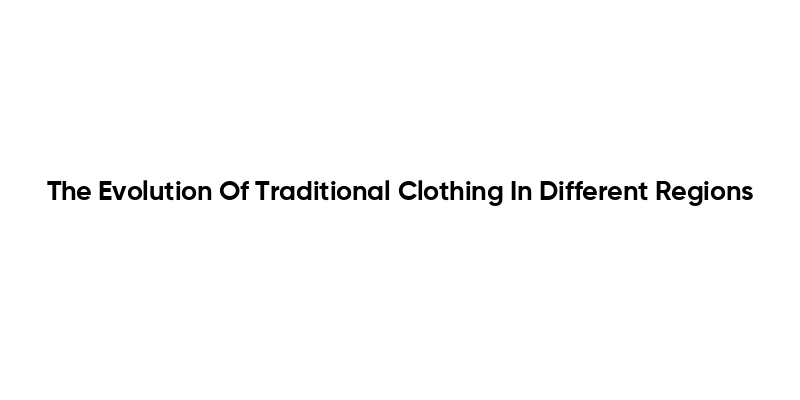The evolution of traditional clothing in different regions is a fascinating journey that reflects the rich tapestry of human culture and history. From the vibrant saris of India to the intricate kimonos of Japan, traditional attire serves as a window into the values, beliefs, and lifestyles of various communities. This article delves into the significant transformations that traditional clothing has undergone over the centuries, influenced by factors such as geography, climate, and social changes. By understanding these evolutions, we can appreciate the deeper meanings behind the garments that have shaped identities across the globe.
As we explore the evolution of traditional clothing, you will discover how historical events, trade routes, and cultural exchanges have played pivotal roles in shaping the attire of different regions. We will examine specific examples, such as the impact of colonialism on African textiles and the revival of indigenous clothing in the Americas. Additionally, we will highlight the role of modern fashion trends in reinterpreting traditional garments, creating a unique blend of old and new that resonates with contemporary audiences.
Join us on this enlightening journey as we uncover the stories behind traditional clothing and its evolution across various cultures. Whether you are a fashion enthusiast, a history buff, or simply curious about the world around you, this exploration promises to enrich your understanding of how clothing is not just a means of covering the body, but a powerful expression of cultural heritage. Read on to discover the intricate connections between clothing, identity, and history!
Traditional clothing serves as a reflection of cultural identity, history, and social status. Over time, these garments have evolved due to various factors such as globalization, technological advancements, and changing societal norms. This article explores the evolution of traditional clothing across different regions, highlighting key influences and transformations.
Historical Influences on Traditional Clothing
The historical context of a region significantly shapes its traditional clothing. For instance, in Europe, the Renaissance period brought about a shift in fashion, emphasizing elaborate designs and luxurious fabrics. This era saw the emergence of tailored garments that highlighted individualism, contrasting with the more utilitarian clothing of the Middle Ages. Similarly, in Asia, the influence of dynasties and colonialism has led to a rich tapestry of clothing styles, each reflecting the socio-political climate of its time.
In Africa, traditional clothing has evolved through the influence of trade and cultural exchanges. The introduction of new materials and techniques has transformed indigenous garments, blending traditional designs with modern aesthetics. This historical evolution showcases how clothing is not just a personal choice but a narrative of a region’s past.
The Role of Climate and Geography
Climate and geography play crucial roles in shaping traditional clothing. In colder regions, such as Scandinavia, traditional garments are designed for warmth and protection, utilizing materials like wool and fur. In contrast, tropical regions, such as Southeast Asia, favor lightweight fabrics that allow for breathability and comfort in humid conditions. This adaptation to the environment is essential for survival and has influenced the design and functionality of traditional attire.
Moreover, geographical features can lead to distinct regional styles. For example, the mountainous regions of Peru have developed unique textiles and clothing styles that reflect their high-altitude environment. These adaptations highlight the ingenuity of cultures in creating clothing that meets both practical needs and aesthetic values.
Globalization and Its Impact on Traditional Clothing
Globalization has significantly impacted traditional clothing, leading to both the preservation and dilution of cultural identities. The increased accessibility of international fashion trends has resulted in a blending of styles, where traditional garments are often incorporated into modern fashion. This fusion can be seen in the popularity of ethnic prints and designs in Western fashion, which often leads to a commercialization of cultural symbols.
However, globalization also poses challenges to traditional clothing. As global brands dominate the market, local artisans and traditional practices may struggle to survive. This tension raises important questions about cultural appropriation and the need for sustainable practices that honor the origins of traditional clothing while adapting to contemporary demands.
The Influence of Technology on Traditional Clothing
Advancements in technology have revolutionized the production and design of traditional clothing. The introduction of synthetic fabrics and digital printing techniques has allowed for greater creativity and efficiency in garment production. Traditional artisans are now able to experiment with new materials while still honoring their cultural heritage.
Additionally, technology has facilitated the global exchange of traditional clothing styles. Online platforms enable artisans to showcase their work to a wider audience, fostering appreciation for diverse cultural expressions. This technological evolution not only preserves traditional techniques but also encourages innovation within the realm of traditional clothing.
The Future of Traditional Clothing
The future of traditional clothing lies in the balance between preservation and innovation. As younger generations seek to connect with their cultural roots, there is a growing interest in traditional garments. This revival is often accompanied by a desire for sustainable and ethically produced clothing, prompting a re-evaluation of traditional practices.
Moreover, the integration of traditional clothing into contemporary fashion can lead to a renewed appreciation for cultural heritage. By embracing both tradition and modernity, societies can ensure that their traditional clothing evolves while remaining a vital part of their identity. This dynamic interplay will shape the future of traditional clothing across the globe.
| Region | Traditional Clothing | Evolution Factors | Modern Influence |
|---|---|---|---|
| Asia | Kimono (Japan), Sari (India) | Climate, Religion, Cultural Exchange | Western fashion trends, Globalization |
| Africa | Boubou (West Africa), Kanga (East Africa) | Colonial history, Local materials, Tribal identity | Western styles, Urbanization |
| Europe | Dirndl (Germany), Kilt (Scotland) | Historical events, Social class, Regional pride | Fashion industry, Global trends |
| North America | Native American regalia, Cowboy attire | Colonization, Cultural blending, Climate | Pop culture, Fashion cycles |
| South America | Huayruro (Peru), Poncho (Andes) | Indigenous traditions, Colonial influence, Geography | Tourism, Global fashion |
| Oceania | Grass skirts (Hawaii), Lapita pottery designs | Colonial impact, Climate, Cultural practices | Modern fashion, Cultural revival |
This HTML document provides a structured overview of the evolution of traditional clothing across different regions, highlighting the clothing types, factors influencing their evolution, and modern influences.



